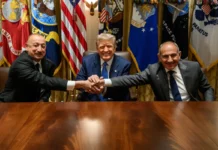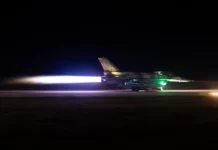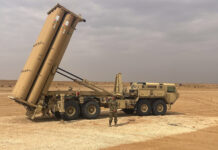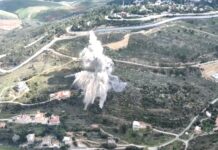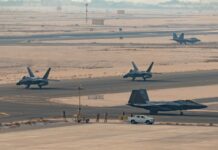Commentators might debate the extent to which US President Donald Trump proactively decided to strike against Iran, as opposed to being drawn into it by the military actions of Israeli Prime Minister Benjamin Natanyahu. However, a line of causality can nevertheless be drawn from the 7 October 2023 terrorist attacks on Israel all the way to Trump ordering the largest strike by B-2 stealth bombers in the type’s operational history.
The 7 October Hamas attack, as the deadliest onslaught against the Jewish people since the Holocaust, was always going to precipitate an Israeli response of considerable vengeance. That Israeli response, in killing tens of thousands of innocent Palestinians in Gaza alongside the Hamas fighters against which it was ostensibly directed, has been perceived by many international observers as crossing the line into the perpetration of war crimes. From a military perspective, however, operations by the Israel Defense Forces (IDF) against Hamas, as well as against Hezbollah paramilitaries in Lebanon – in combination with US and allies strikes against Houthi militants in Yemen – neutered a major Iranian lever that Tehran had used for decades to indirectly attack Israel through the regional proxies it funded and directed.
The negation of that threat cleared the path for Natanyahu on 13 June 2025 to launch Operation ‘Rising Lion’: a major air offensive against Iran that exploited the IDF’s military superiority to target both Iran’s military leadership and the greatest threat to Israel itself: a nuclear weapon programme that Iranian leaders past and present had called to be used to ‘wipe Israel off the map’.
While the views and intelligence on Iran’s progress in weaponising its nuclear programme have been contradictory – even within the Trump Administration – Israeli analysts and commentators could reasonably ask the rhetorical question, ‘Just how long is Israel supposed to wait as Iran moves toward completing a viable nuclear weapon?’
Operation ‘Rising Lion’ represents the largest attack on Iran since the 1980-89 Iran-Iraq War, yet there were Iranian targets buried deep underground – the uranium enrichment infrastructure at Fordow and Natanz – that only the B-2-delivered 30,000 lb (13,608 kg) GBU-57 Massive Ordnance Penetrator (MOP) munition has any likelihood of destroying.
Following the initiation of Operation ‘Rising Lion’, Trump did warn Iran of serious consequences unless they negotiated, yet the leadership in Tehran chose not to engage. Thus, with the Israeli Air Force having largely destroyed much of Iran’s air defences, the path was clear for the US Air Force to mount the kind of raid that the US and Israeli leadership hope has significantly altered the military-geopolitical balance in the Middle East to Iran’s disadvantage.
How Operation ‘Midnight Hammer’ happened
As explained by US Chairman of the Joint Chiefs of Staff General Dan Caine in a Pentagon briefing on 22 June, Operation ‘Midnight Hammer’ began at 00.01 EST on the morning of 21 June 2025 when a strike package of B-2 Spirit stealth bombers took off from Whiteman Air Force base in Missouri. While some of the bombers flew to the west and into the Pacific as a decoy, the main strike force of seven B-2s embarked on an 18-hour flight to their targets in Iran, during which they were refuelled in the air multiple times but maintained minimal communications to preserve surprise.
Once over land, the B-2s linked up with escort and support aircraft in what Gen Caine called “a complex, tightly timed manoeuvre requiring exact synchronisation across multiple platforms in a narrow piece of airspace, all done with minimal communications”.
At around 17.00 EST on 21 June, just prior to the B-2 strike package entering Iranian airspace, a US submarine in the Central Command area of responsibility launched more than two dozen Tomahawk land attack cruise missiles against key surface infrastructure targets at the Iranian nuclear facilities at Esfahan, said Gen Caine.
The general further explained that, as the B-2 strike package entered Iranian airspace, the US aircraft involved in the raid employed several deception tactics, including decoys, as the fourth- and fifth-generation aircraft pushed out in front of the strike package at high altitude and high speed, sweeping in front of the package for enemy fighters and surface-to-air missiles. Gen Caine said the US military is “currently unaware of any shots fired at the US strike package on the way in”.
The chairman of the Joint Chiefs then detailed exactly how the B-2s prosecuted their attack. “At approximately 6:40 pm Eastern Standard Time, 2:10 am Iran time, the lead B-2 dropped two GBU-57 Massive Ordnance Penetrator (MOP) weapons on the first of several aim points at Fordow,” he said. “The remaining bombers then hit their targets as well, with a total of 14 MOPs dropped against two nuclear target areas. All three Iranian nuclear infrastructure targets were struck between 6:40 pm and 7:05 pm Eastern time again. That’s about 2:10 in the morning local time in Iran, with the Tomahawk missiles being the last to strike at Esfahan to ensure we retained the element of surprise throughout the operation. Following weapons release, the ‘Midnight Hammer’ strike package exited Iranian airspace and the package began its return home.”
The general added that he is “unaware of any shots fired at the package on the way out”, that “Iran’s fighters did not fly”, and that “it appears that Iran’s surface-to-air missile systems did not see us”.
Gen Caine summarised that Operation ‘Midnight Hammer’ employed “more than 125 US aircraft … including B-2 stealth bombers, multiple flights of fourth- and fifth-generation fighters, dozens and dozens of air refuelling tankers, a guided missile submarine, and a full array of intelligence, surveillance and reconnaissance aircraft”. The strike assets involved used around 75 precision-guided weapons, including the 14 GBU-57 MOPs in what was this weapon’s first ever operational use.
As Gen Caine conducted his press conference at the Pentagon in conjunction with US Defense Secretary Pete Hegseth, a bomb damage assessment (BDA) of the results from Operation ‘Midnight Hammer’ was still pending and he declined to offer an opinion on the damage caused.
Hegseth, meanwhile, stated, “Our initial assessment … is that all of our precision munitions struck where we wanted them to strike and had the desired effect, which means especially in Fordow, which was the primary target here. We believe we achieved destruction of capabilities there.”
What happens next?
US forces in based around the Middle East will now have to be on high alert for any potential Iranian reprisals for some time to come. There is also a danger that Iran could mine the Strait of Hormuz, causing economic chaos by closing off what is considered the world’s most vital oil transit choke point.
Few in Israel will worry about that, however. The actions of the IDF since 7 October 2023, however controversial, have ultimately probably precipitated the achievement of the Israeli state’s greatest strategic objective in the modern era in seeing the Iranian nuclear threat negated, at least in the near to medium term.
Following Operation ‘Midnight Hammer’ Iran initially responded on 22 June by launching a wave of missiles at Israel, which Netanyahu characterised as “just more of the same”. The Israeli prime minister added that Israel is willing to end its strikes on Iran, but only if Tehran agrees to dismantle its nuclear programme, asserting that the onus is on Iran, “not on us”, to end the conflict. “We are happy to wrap it up now,” Netanyahu added. “If there’s an agreement at the end, Israel will be content with the result.”
For President Trump, meanwhile, Operation ‘Midnight Hammer’ reverses a trend where his actions on the world stage have been ineffective. Indeed, following Trump’s ordering of the assassination of General Qasam Soleimani, commander of the Iranian Islamic Revolution Guard Corps’ Quds Force, with a drone strike on 3 January 2020, US policy in dealing with Iran is one area where Trump has acted decisively.
Within Trump’s Make America Great Again (MAGA) political base there have been dissenting voices in light of Operation ‘Midnight Hammer’, given that Trump came to power for a second term claiming he would keep Americans out of “endless” or “forever wars” and remove “warmongers and America-last globalists”.
However, entering a war is not what Trump has done; to do so would have required the approval of the US Congress, while strikes such as Operation ‘Midnight Hammer’ are certainly within Trump’s remit as the US military’s commander-in-chief.
Trump is no student of history, and the foreign policy of his administration is generally the poorer for this, but the history of US foreign policy over the last 30 years shows that the use of surgical military strikes at least has the potential to be a more effective geopolitical instrument than putting ‘boots on the ground’. During Operation ‘Infinite Reach’ on 20 August 1998 US President Bill Clinton ordered the targeting of Al-Qaeda terrorist facilities in Afghanistan and Sudan with cruise missiles launched by the US Navy following Al-Qaeda’s bombing of the US embassies in Kenya and Tanzania on 7 August of that year. The strikes ultimately proved controversial when a pharmaceutical facility at Al-Shifa in Sudan was destroyed after being incorrectly identified as a chemical weapon production facility. Operation ‘Infinite Reach’, in additionally targeting Al-Qaeda terrorist training camps in Afghanistan, also failed in its attempt to assassinate Al-Qaeda leader Osama bin Laden – the only US military attempt to do so prior to the terrorist attacks on the United States of 9 September 2001. Had the operation succeeded in this objective, however, 21st Century world history might have looked significantly different.
With Operation ‘Midnight Hammer’, meanwhile, the Trump Administration will be hoping that it has, indeed, made a significant difference to military geopolitics in the Middle East.











